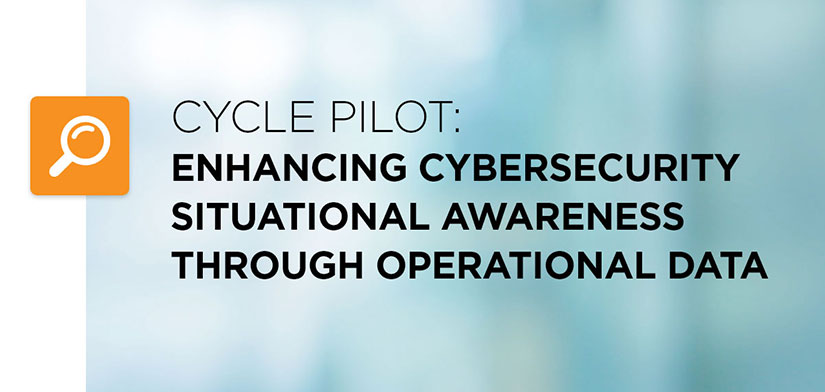Cybersecurity Accelerator Expands To Speed Commercialization of Department of Energy Technologies
New Critical Energy Cybersecurity Accelerator Track Focuses on Advancing Government Technologies That Fill Critical Cybersecurity Technical Gaps

The transition from concept to adoption can be a difficult hurdle for emerging technologies to overcome. Commercialization costs, access to testing facilities, and scalability are all challenges that can stall or impede a technology’s journey to market, resulting in a gap between concept and adoption.
The Critical Energy Cybersecurity Accelerator™ (CECA) has launched a new track to help technologies across the U.S. Department of Energy’s (DOE’s) 17 national laboratories bridge this gap. Currently wrapping up its pilot phase, the track is focused on advancing the technology readiness levels (TRLs) of cutting-edge cybersecurity technologies within DOE’s portfolio that fill critical technical gaps within the current marketplace.
“There are cutting-edge cybersecurity research and technologies being worked on across the national labs, but they aren’t always built in such a way that they can be easily used by industry,” said Nik Urlaub, principal investigator for CECA. “This new track aims to help these emerging cybersecurity technologies within the national lab complex have a greater impact.”
The new premarket track is designed to complement CECA’s existing market-ready track, which evaluates commercial technologies that offer solutions to high-priority risks and challenges identified by utilities. Technologies in the new track receive iterative laboratory testing in realistic energy environments, commercialization support, and resources for industry engagement. They are also benchmarked, pre- and post-evaluation, against DOE’s Technology Readiness Assessment Guide and Adoption Readiness Assessment.

“When we look at TRLs for national laboratory technologies, we see a lot of government funding for levels 1–3, which is the early-stage, proof-of-concept work,” Urlaub said. “Funding for these technologies often slows when they reach levels 4–6, when they experience market readiness gap.”
In the pilot phase of the premarket track, CECA evaluated the Cybersecurity Situational Awareness Tool (CYSAT), an advanced threat detection tool for real-time awareness of cyber and physical assets. The CECA research team exposed the tool to new environments, new technologies, new data, and new attack scenarios using the Advanced Research on Integrated Energy Systems (ARIES) Cyber Range, a research environment that provides precise and verifiable testing and allows users to replicate energy assets, connections, and communication networks at scale. Through testing, the CYSAT development and CECA research teams expanded the tool’s application, added functionality, improved its scalability, and increased its capabilities in support of achieving TRL 4. Commercialization support through the program is helping the CYSAT development team identify steps toward higher TRLs.
“CYSAT leverages artificial intelligence methods and data-driven approaches to analyze data streams and detect anomalies, providing situational awareness to operators of power systems across all scales,” said Vivek Kumar Singh, principal investigator of CYSAT. “Many utilities and industry vendors have shown interest in conducting pilot tests and field demonstrations, and we are developing future plans with more case studies.”
Technologies in both the premarket and market-ready tracks are evaluated for their performance against simulated attacks based on real-world threats in the ARIES Cyber Range.
As the new premarket track expands from pilot to operation, future cycles will explore new technologies and test scenarios and increase environment fidelity to meet the needs of future energy systems. These could include scenarios testing technologies’ interactions with many grid-edge devices, highly distributed energy resources, and fleets of electric vehicles.
CECA was established in 2021 by DOE’s Office of Cybersecurity, Energy Security, and Emergency Response (CESER) and the National Renewable Energy Laboratory (NREL) and has completed two cohorts in its market-ready track. Cohort 1 evaluated market-ready technologies from Blue Ridge Networks, Sierra Nevada Corporation, and Xage Security, which offer authentication and authorization of devices on utility networks. Cohort 2 tested solutions from runZero and Asimily, which offer the ability to uncover hidden risks within utility industrial control systems.
CECA’s market-ready and premarket tracks are designed to be mutually reinforcing—utility advisors from the market-ready track provide insights to technology partners about what development paths might be desirable and inform test environments. The premarket track can also introduce technologies to utilities, potential investors, and partners in the market-ready track that can be of value in their commercialization journey.
As mentioned in the National Cybersecurity Strategy, CECA is supporting enhanced cybersecurity in the energy sector by ensuring that both current and emerging technologies are effectively evaluated and optimized for utility needs.
Industry and government technology owners who are interested in being considered for future evaluations are invited to email [email protected].
CECA is managed by NREL and sponsored by DOE CESER and utility partners in collaboration with DOE’s Office of Energy Efficiency and Renewable Energy.
Read more about CECA and program eligibility, and subscribe to CECA email updates.
Last Updated May 28, 2025
